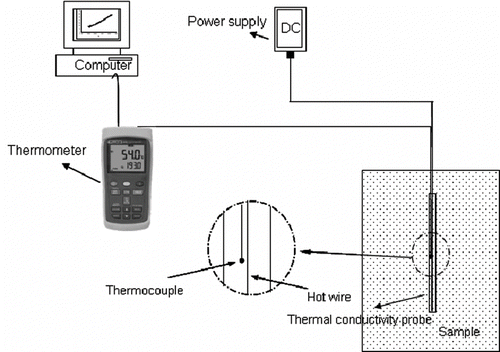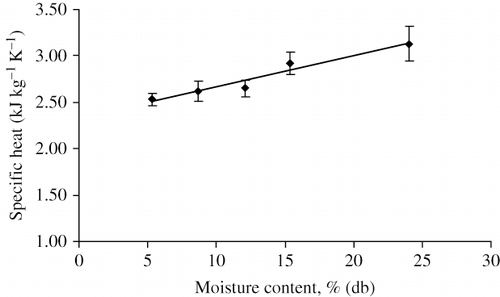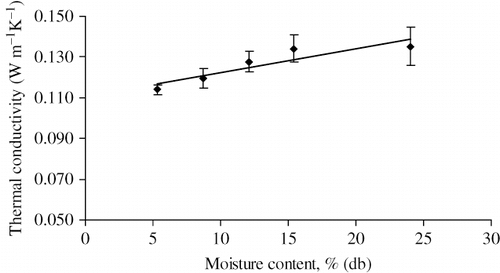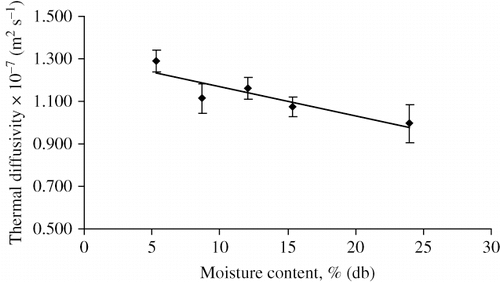Abstract
The selected thermal properties, namely specific heat, thermal conductivity and thermal diffusivity were determined for pumpkin seeds in the moisture content range of 5.32–24.00% (d.b.). Specific heat was determined using the method of mixtures. Thermal conductivity was measured by the transient technique using the line heat source method assembled in a thermal conductivity probe. Specific heat, thermal conductivity, and thermal diffusivity of pumpkin seeds were found between 2.53 and 3.13 kJ kg−1K−1, 0.113, and 0.135 W m−1K−1, 9.954 × 10−8 and 1.289 × 10−7 m2 s−1, respectively, under the conditions with by changing moisture content. Specific heat and thermal conductivity of pumpkin seeds increased with increasing moisture content, while thermal diffusivity decreased with the increase in moisture content.
INTRODUCTION
Nowadays, foods are processed and served to consumer in numerous ways with the help of technological developments in food industry. Thermal processes are widely applied to foods to obtain high quality products. Therefore, thermal properties of agricultural materials and foods need to be known to better understand their nature and to be able to develop new technologies. Properties of food materials vary drastically under various thermal conditions affecting their physical, chemical and nutritional properties.
Specific heat, thermal conductivity, and thermal diffusivity are important thermal properties. Specific heat has an important role in determination of energy cost and for the dimensions of machinery and equipment that are needed in thermal processes. Furthermore, specific heat of food materials changes according to their physical and chemical properties. Thermal conductivity depends mainly on moisture content, temperature, porosity, and distribution of component phases.[Citation1] Therefore, several experimental studies on determination of thermal properties of food and agricultural materials were reported in literature; on cumin seed (Sing and Goswami[Citation2]); rough rice (Yang et al.[Citation3]); African yam bean (Irtwange and Igbeka[Citation4]); parchment coffee bean (Perez et al.[Citation5]); minor millet grain and flours (Subramanian and Viswanathan[Citation6]); wheat (Tavman and Tavman[Citation7]); mushrooms (Shrivastava and Datta[Citation8]); chickpea (Sabapathy and Tabil[Citation9]); corn, sunflower, wheat, and barley (Kayisoglu et al.[Citation10]); and borage seeds (Yang et al.[Citation11]). Krokida et al. [Citation12] selected and presented data in the literature for thermal conductivity of foodstuffs obtained from various scientific sources, and Maraulis et al.[Citation13] also studied on improving a mathematical model to estimate the thermal conductivity of some foodstuffs as a function of moisture content and temperature, and to fit the model simultaneously to a data available in the literature. However, no study has been reported on thermal properties of pumpkin seed in the literature.
Pumpkin seed (Cucurbitae pepo L.) is an agricultural product with economical interest to some European countries and has considerable nutritional value for human consumption due to its 37.8–45.4% oil and 25.2–37.0% protein contents. It also has valuable dietetic and medicinal advantages besides being a source of edible oils, proteins and minerals of good quality.[Citation14] The seed of pumpkin is eaten as a snack after roasting by separating the kernels from hulls and gives good results in curing prostate. The oil extracted from the pumpkin seed is commonly used as salad oil.[Citation15] Moisture content of the pumpkin seed is very high during harvest (30–35% wet basis). Seeds must be dried for storage, handling and processing. The moisture content of the roasted pumpkin seeds must not exceed 6% (w.b.) for a good quality product.[Citation16] Different heating techniques are applied to pumpkin seeds during handling and processing which affect the quality of the product. The arrangement and design of these technological processes are the most important factors for food quality. The aim of this research was to determine the specific heat, bulk thermal conductivity, and bulk thermal diffusivity of pumpkin seed as a function of moisture content.
MATERIALS AND METHOD
Samples Preparation
The pumpkin seeds were obtained from the local market. The seeds were cleaned from foreign materials such as stone, sand, soil etc. and the initial moisture content of seeds was determined by using the vacuum oven method at 70oC for 24 h.[Citation17,Citation18] The initial moisture content of the seed was 5.32% (d.b.). Some predetermined quantity of distilled water was added to the samples to enhance moisture content of seeds. Later, samples were packed in sealed moisture resistant flexible bags and kept at + 4oC in a refrigerator for 48 h to ensure uniform moisture distribution.[Citation2,Citation3,Citation4] Samples were held in laboratory for them to reach room temperature and to release the free moisture before starting the experiment. Experiments were conducted at five different moisture contents of 24.00, 15.40, 12.10, 8.70, and 5.32% (d.b.), respectively.
Measurement of Specific Heat
The method of mixtures, which is accepted one of the most suitable methods for seeds and grains,[Citation1] was used to determine the specific heat (cs ) of pumpkin seeds.[Citation1,Citation5,Citation6] This method is based on the heat gain of the cold source which is equivalent to the heat loss of the hot source, in isometric condition. Specific heat measuring apparatus consisted of a calorimeter with a capacity of 300 ml, test capsule, thermocouples, heater and temperature measuring equipment. The calorimeter (75.0 mm height, 70.0 mm inner diameter) was a composite of copper, insulation material and polyvinyl chloride. A cylindrical aluminum test capsule (50.6-mm height, 44.0-mm outer diameter, and 1.5-mm wall thickness) was used in the calorimeter to prevent samples from absorbing water. The heat capacity of empty cylindrical aluminum test capsule was determined experimentally. Calibration of the calorimeter was done using distilled water (cw = 4.187 kJ kg−1K−1) in test capsule. The samples were filled in the test capsule without leakage and the capsule containing the samples was dropped into the hot distilled water in calorimeter at 358 K. The temperature change was recorded at an interval of 1 s with Fluke 54 II thermometer and K type thermocouple (Fluke Corporation, USA). After reaching the equilibrium temperature namely not changing the temperature, measurement was stopped and the specific heat was calculated using EquationEqs. (1) and Equation(2):[Citation1,Citation5,Citation6]
where cs is specific heat of the sample (kJ/kg K); cw is specific heat of water (kJ/kg K); cca is specific heat of the capsule (kJ/kg K); ww is mass of water in the calorimeter (kg); wca is mass of the capsule (kg); ws is mass of the sample (kg); Tca is initial temperature of the capsule containing the sample (K); Te is equilibrium temperature of the mixture (K); Tw is initial temperature of water in the calorimeter (K) and Ts is the initial temperature of the sample (K). Experiments were repeated three times for each moisture level to determine the effect of moisture content of seeds on specific heat.
Measurement of Thermal Conductivity
Thermal conductivity of pumpkin seed was determined by thermal conductivity probe method using line heat source principle.[Citation1,Citation2,Citation7,Citation8,Citation9,Citation10] The experimental apparatus for determination of thermal conductivity was shown in Fig.1. The thermal conductivity probe, which was built in the laboratory conditions in this study, was constructed from glass material and had a diameter of 3.84 mm, a length of 130.0 mm with a thickness of 0.27 mm. The heating wire used for heating apparatus had a diameter of 0.4 mm and a length of 130.0 mm (10.74 Ω m−1). Temperature rise was measured using K-type thermocouple of 0.5 mm diameter. The pumpkin seed was filled in cylindrical container then, the container was closed by a lid with a hole right in the center () and later, the thermal conductivity probe was inserted into the bulk of pumpkin seed through the hole. A 4.5 V voltage and 1.2 A current was applied to thermal conductivity probe which was inserted into the center of the sample. The temperature (T) increases were recorded for 90 seconds with one-second intervals when the power was on. Then the power was switched off and the decreases were recorded for 90 seconds with one-second intervals. The maximum slope method was used to calculate the thermal conductivity of pumpkin seed and thermal conductivity (k) of a sample was calculated using the following equation[Citation2,Citation7,Citation8,Citation9];
where k is bulk thermal conductivity (W m−1K−1); Q is the heat input per unit length of hot wire (W m−1); t is time (s); T is temperature (K). Local slope (S) and the coefficient of determination (R2) of temperature versus the lnt were determined for each 5 data point sequence from 1st to 90th data with no overlap using linear regression analysis. Local slope was calculated using the following equation.[Citation1,Citation2,Citation7,Citation8,Citation9,Citation10]Equation
The maximum slope obtained from the curve of local slopes versus time was determined based on the highest slope value and the highest R2 for the thermal conductivity calculation.[Citation7,Citation8,Citation9,Citation10,Citation11] The heat in EquationEq. (3) was generated in a hot wire at a rate Q:Equation
where I is electric current (A) and R is the electric resistance per unit length hot wire (Ω m−1).
When EquationEq. (3) was reorganized, the thermal conductivity of pumpkin seed was calculated using the EquationEq. (6) [Citation7,Citation8,Citation11];
Experiments were repeated three times for each moisture level to determine the effect of moisture content of pumpkin seeds on thermal conductivity.
Thermal Diffusivity Calculation
The thermal diffusivity (α) of pumpkin seeds was calculated from experimentally determined values of specific heat, thermal conductivity and bulk density using Eq. (7) [Citation2,Citation4];
where α is the thermal diffusivity (m2 s−1); k is the thermal conductivity (W m−1 K−); cs is the specific heat (kJ kg−1 K−1) and ρ is the bulk density of pumpkin seeds (kg m−3). An analysis of variance (ANOVA) procedure of Minitab 14.0 Software (Minitab Inc., State Park, PA) was used to determine the significance (p < 0.05) of the effects of the moisture content on the specific heat, thermal conductivity and thermal diffusivity of pumpkin seed and to construct linear regression equations to predict specific heat, thermal conductivity, and thermal diffusivity of pumpkin seed.
RESULTS AND DISCUSSION
Specific Heat
Specific heat of pumpkin seeds was determined between 2.53–3.13 kJ kg−1K−1 in the moisture content range of 5.32–24.00% (d.b.) (). Specific heat of pumpkin seed was affected by the moisture content. A linear relationship between moisture content and specific heat was found after regression analysis (). Specific heat increased with the increase in moisture content of the seeds (). These results are supported by the findings of other researchers: Subramanian and Viswanathan[Citation6] found that the specific heat of six type of millet and their flour varied from 1.33 to 2.40 kJ kg−1 K−1 in the moisture content range of 10–30%. Singh and Goswami[Citation2] observed a rise in specific heat of cumin seed from 1.33 to 3.09 kJ kg−1 K−1 with a rise in moisture from 11.2 to 22% (w.b.); Hsu et al.[Citation19] found a linear relationship between the specific heat and the moisture content for pistachios; Subramanian and Viswanathan[Citation6] for six type of millet and their flour; Yang et al.[Citation11] for borage seed; Singh and Goswami[Citation2] for cumin seed; Perez-Alegria et al.[Citation5] for parchment coffee bean.
Table 1 Thermal properties of pumpkin seed as affected by moisture content
Table 2 Regression equations for specific heat, thermal conductivity and thermal diffusivity
Thermal Conductivity
The thermal conductivity of pumpkin seeds was found between 0.113–0.135 W m−1K−1 with varying moisture content in the range of 5.32–24.00% (d.b.) (). The moisture content affected significantly the thermal conductivity which increased linearly with the increase in the moisture content (, ). Irtwange and Igbeka[Citation20] found that the thermal conductivity of African yam bean varied from 0.217 to 0.302 W m−1K−1 in the moisture content range of 4–16%. Tavman and Tavman[Citation7] found that the thermal conductivity of three varieties of wheat increased linearly with the increase in the moisture content in range of the 9.17–38.65%. Subramanian and Viswanathan[Citation6] reported that the thermal conductivity of six types of millet and their flour increased linearly with the increase in the moisture content in the range of 10–30%. Similarly, a linear relationship was found between thermal conductivity and moisture content for borage seed,[Citation11] for rough rice,[Citation3] for corn, sunflower, wheat and barley,[Citation10] for cumin seed,[Citation2] for parchment coffee bean,[Citation5] and for beans.[Citation21]
Thermal Diffusivity
The thermal diffusivity was determined as 9.954 × 10−8 – 1.289 × 10−7 m2 s−1 in the moisture content range of 5.32–24.00% (d.b.) (). The thermal diffusivity decreased linearly with the increase in moisture content (Fig.4). A relation was determined between the moisture content of pumpkin seed and thermal diffusivity. After regression analysis for thermal diffusivity with respect to moisture content, the regression equation was obtained. Because of small changes in the densities for different moisture contents, the thermal diffusivity had a low relationship with the moisture content (). Singh and Goswami[Citation2] reported that the thermal diffusivity was between 14.72 × 10−8 – 12.87 × 10−8 m2 s−1 in the moisture content range of 1.8–11.1% (d.b.) at 10oC. Thermal diffusivity decreased with the increase in moisture content for six varieties of millet seeds and their flour,[Citation6] borage seeds,[Citation11] and cumin seeds.[Citation2] The negative linear relationship was found between thermal diffusivity and moisture content. Tavman et al.,[Citation22] Subramanian and Viswanathan[Citation6] and Yang et al.[Citation3] reported their results with similar tendencies.
CONCLUSION
In this research, the thermal properties of pumpkin seeds such as specific heat, thermal conductivity and thermal diffusivity were determined. Specific heat, thermal conductivity and thermal diffusivity of pumpkin seeds for the moisture content range of 5.32–24.00% (d.b.) were determined between 2.53–3.13 kJ kg−1K−1, 0.113–0.135 W m−1K−1, and 9.954 × 10−8 – 1.289 × 10−7 m2 s−1, respectively. It was found that the thermal properties of pumpkin seeds are extremely dependent on moisture content. Specific heat and thermal conductivity of pumpkin seeds increased with increasing moisture content, while thermal diffusivity decreased with the increase in moisture content.
NOMENCLATURE
| cs | = |
Specific heat of sample (kJ kg−1 K−1) |
| cw | = |
Specific heat of water (kJ kg−1 K−1) |
| cca | = |
Specific heat of the capsule (kJ kg−1 K−1) |
| ww | = |
Mass of water in the calorimeter (kg) |
| wca | = |
Mass of the capsule (kg) |
| ws | = |
Mass of sample (kg) |
| Te | = |
Equilibrium temperature of the mixture (K) |
| Tca | = |
Initial temperature of the capsule containing the sample (K) |
| Tw | = |
Initial temperature of water in the calorimeter (K) |
| Ts | = |
Initial temperature of sample (K) |
| k | = |
Thermal conductivity (W m−1K−1) |
| t | = |
Time (s) |
| Q | = |
Heat input per unit length of hot wire (W m−1) |
| I | = |
Electric current (A) |
| R | = |
Electric resistance per unit length hot wire (Ω m−1) |
| α | = |
Thermal diffusivity (m2 s−1) |
| ρ | = |
Bulk density of pumpkin seeds (kg m−3) |
REFERENCES
- Mohsenin , N.N. 1980 . Thermal Properties of Food and Agricultural Materials , New York : Gordon and Breach Science Publishers .
- Singh , K.K. and Goswami , T.K. 2000 . Thermal properties of cumin seed . Journal of Food Engineering , 45 : 181 – 187 .
- Yang , W. , Siebenmorgen , T.J. , Thielen , T.P.H. and Cnossen , A.G. 2003 . Effect of glass transition on thermal conductivity of rough rice . Biosystems Engineering , 84 : 193 – 200 .
- Irtwange , S.V. and Igbeka , J.C. 2003 . Influence of moisture content on thermal diffusivity and specific heat of African Yam Bean (Sphenostylis stenocarpa) . Transactions of the ASAE , 46 : 1633 – 1636 .
- Perez-Alegria , L.R. , Ciro , H.J. and Abud , L.C. 2001 . Physical and thermal properties of parchment coffee bean . Transactions of the ASAE , 44 : 1721 – 1726 .
- Subramanian , S. and Viswanathan , R. 2003 . Thermal properties of minor millet grains and flours . Biosystems Engineering , 84 : 289 – 296 .
- Tavman , S. and Tavman , I.H. 1998 . Measurement of effective thermal conductivity of wheat as a function of moisture content . International Community Heat Mass Transfer , 25 : 733 – 741 .
- Shrivastava , M. and Datta , A.K. 1999 . Determination of specific heat and thermal conductivity of mushrooms (Pleurotus florida) . Journal of Food Engineering , 39 : 255 – 260 .
- Sabapathy, N.; Tabil, L.G. Thermal conductivity of kabuli type chickpea. ASAE/CSAE North Central Intersectional Meeting, Fargo, North Dakota, October 3-4, 2003, ASAE Paper No. RRV03-0012 http://www.ageng.ndsu.nodak.edu/asae/rrv/RRV03-0012.pdf (Accessed: 5 October 2006 ).
- Kayisoglu , B. , Kocabiyik , H. and Akdemir , B. 2004 . The effect of moisture content on the thermal conductivities of some cereal grains . Journal of Cereal Science , 39 : 147 – 150 .
- Yang , W. , Sokhansanj , S. , Tang , J. and Winter , P. 2002 . Determination of thermal conductivity, specific heat and thermal diffusivity of boroge seeds . Biosystems Engineering , 82 : 169 – 176 .
- Krokida , M.K. , Panagiotou , N.M. , Maroulis , Z.B. and Saravacos , G.D. 2001 . Thermal conductivity: literature data compilation for foodstuffs. International . Journal of Food Properties , 4 ( 1 ) : 111 – 140 .
- Maroulis , Z.B. , Saravacos , G.D. , Krokida , M.K. and Panagiotou , N.M. 2002 . Thermal conductivity prediction for foodstuffs: effect of moisture content and temperature. International . Journal of Food Properties , 5 ( 1 ) : 231 – 245 .
- Yoshida , H. , Shougaki , Y. , Hirakawa , Y. , Tomiyama , Y. and Mizushina , Y. 2004 . Lipid classes, fatty acid composition and triacyglycerol molecular species in the kernels of pumpkin (Cucurbita spp) seeds . Journal of the Science Food and Agriculture , 84 : 158 – 163 .
- Murkovic , M. and Pfannhauser , W. 2000 . Stability of pumpkin seed oil . European Journal of Lipid Science and Technology , 102 : 607 – 611 .
- Akritidis , C.B. , Tsatsarelis , C.A. and Bagiatis , C.B. 1988 . Equilibruim Moisture Content of Pumpkin Seed . Transactions of the ASAE , 31 : 1824 – 1827 .
- AOAC . 1990 . Official method of analysis , Washington, DC : Association of Official Analytical Chemists (No. 934.06) .
- Sacilik , K. 2007 . Effect of drying methods on thin-layer drying characteristics of hull-less seed pumpkin (Cucurbita pepo L.) . Journal of Food Engineering , 79 : 23 – 30 .
- Hsu , M.H. , Mannapperuma , J.D. and Singh , R.P. 1991 . Physical and thermal properties of pistachios . Journal Agricultural Engineering Research , 49 : 311 – 321 .
- Irtwange , S.V. and Igbeka , J.C. 2002 . Some physical properties of two African yam bean (Sphenostylis stenocarpa) accessions and their interrelations with moisture content . Applied Engineering in Agriculture , 18 : 567 – 576 .
- Thomeo , J.C. , Costa , M.V.A. and Lopes Filho , J.F. 2004 . Effective thermal conductivity of beans via a steady-state method. International . Journal of Food Properties , 7 : 129 – 138 .
- Tavman , S. , Tavman , I.H. and Evcin , S. 1997 . Measurement of thermal diffusivity of granular food materials . International Community Heat Mass Transfer , 24 : 945 – 953 .



